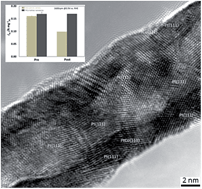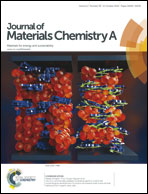Dealloyed PtCo hollow nanowires with ultrathin wall thicknesses and their catalytic durability for the oxygen reduction reaction†
Abstract
The poor durability and high cost of Pt nanoparticles have always been challenges to the commercialization of proton exchange membrane fuel cell (PEMFC)-powered vehicles. Pt-based nanowires have better durability and catalytic activity. Hollow nanowires reduce Pt consumption and thus save cost. In this paper, PtCo hollow nanowires with well-controlled ultrathin wall thicknesses of 2–4 nm have been synthesized by electrospinning, annealing and dealloying. To the best of our knowledge, these are the thinnest walls yet achieved by the use of electrospinning. The mechanism of hollow nanowire evolution is studied. It is found that the reduction temperature is crucial for the retention of the hollow structure. In contrast to conventional Pt/C nanoparticles which lose 38% of their initial activity, these ultrathin hollow nanowires exhibit well-preserved activities after 10 000 cycles. Our studies raise promising possibilities for synthesizing highly durable Pt-based catalysts.


 Please wait while we load your content...
Please wait while we load your content...